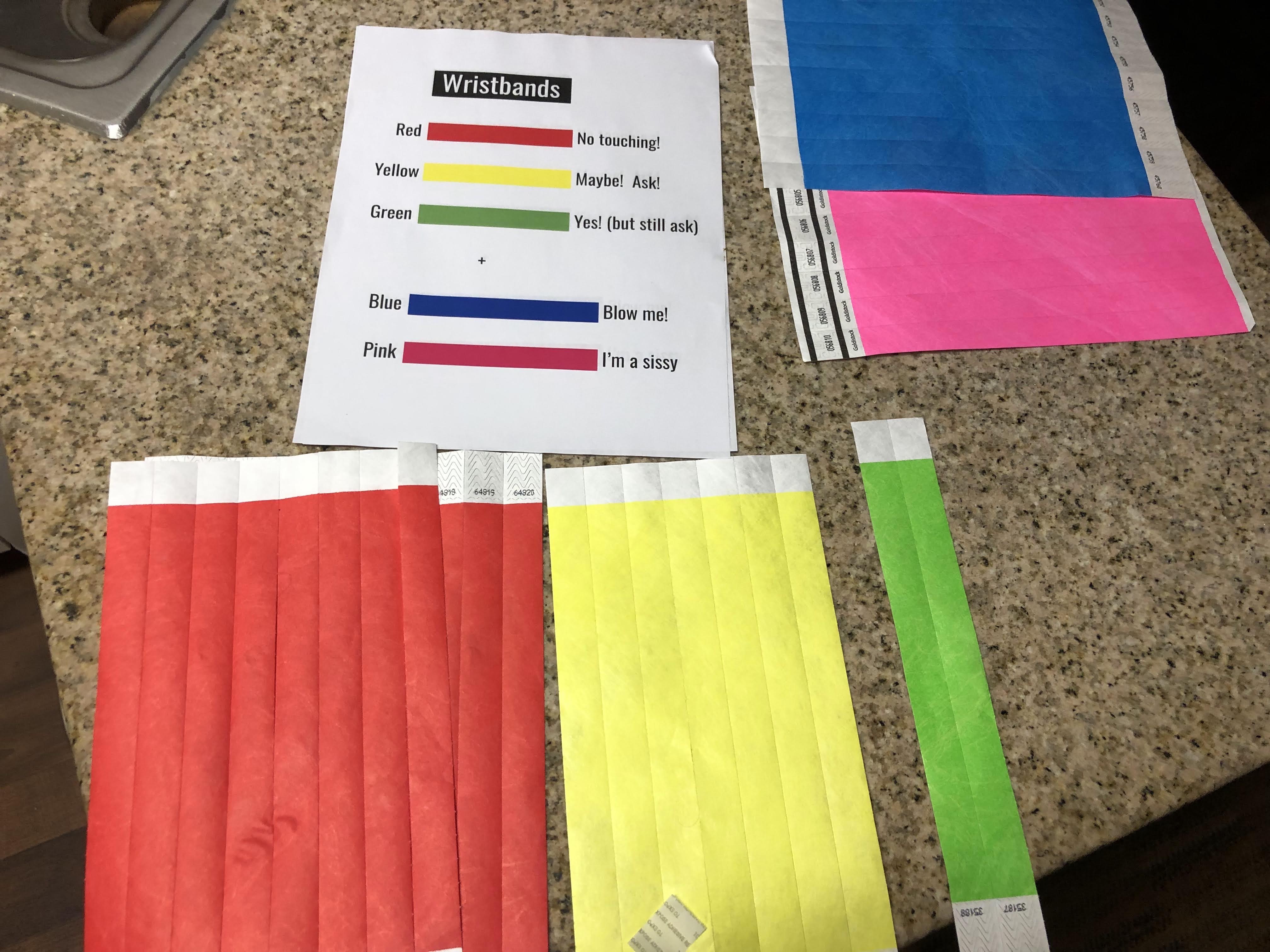What color wristband should I pick?
Published: Category: Advice Estimated Reading Time: ~4 minutes wristbands sex default yes
People often ask me what color wristband they should pick at my parties. Here’s my advice on making this important decision.
When you arrive at my parties you get to pick a colored wristband:
- Traffic light colors:
- red (stop; no touching; don’t even ask)
- yellow (maybe… ask!)
- green (yes! please ask!)
- Two optional “add on” colors:
- pink (Eager to suck)
- blue (Blow me!)

How do you decide?
Some people “just know”. They came to the party already knowing they want a green, or a red, or whatever. Great! Good for you! You don’t have to read the rest of this article.
What if you are unsure? If you are having trouble deciding between two colors, pick the less risky one. Can’t decide between green or yellow? Pick yellow. Can’t decide between yellow and red? Red is the safe choice.
Why? Because safety is important. I want everyone to have a safe, enjoyable time. You can always change colors during the party. Start with the safer choice.
That said, there is another way to make your decision.
I used to be a “default no” kind of guy. If I wasn’t sure about something, the safest thing to do would be to say “no”. That clearly set my boundaries to be on the safe side.
The problem is that if you do this you’ll miss out on a lot of fun.
This is a true story. I used to go to kink clubs and stand around and do nothing. I’d mostly watch. In fact, once I drove 5 hours to go to an amazing kink party and did nothing but hang out in the snack area eating potato chips.
When I got home I thought about what happened. Why was I driving 5 hours and not having a good time? Well, it turned out I did get a number of offers, but my “default no” habit kicked in. One time I thought, “Gosh, that’s a nice offer but what if a better offer comes along?” Another time I thought, “That offer is from someone who is pretty experienced and hardcore. What if it’s too much for a beginner like me?”
Well, that “default no” philosophy got me nowhere.
“What if the next offer is better” is a bad excuse. If you say that to every offer, you’ll never do anything.
“They’re too experienced” is also a bad excuse. Experienced people know all about negotiation. In fact, they expect people to negotate. If they ask to do things that are too kinky for me, they expect me to speak up and say so. More importantly many experienced people love to teach new people. In fact, that’s probably why I got the offer! I just passed up the opportunity to learn from the best!
Anyway…
The next time I went to that party I adopted my new “default yes” approach. Guess what? I played with more people during that party than all previous parties!
When a person suggested we do things beyond my limits, I said “no” and they respected my boundaries. When they offered to do things I hadn’t done before, I said “I’m nervous because I haven’t done that” and they were excited to go slow and teach me!
In fact, because I was playing, more people wanted to play with me!
“Default yes” is awesome!
Of course, “default yes” is more risky. It is best used when you are in an environment full of experienced people you can trust. The party I was at was invite-only and everyone was screened.
Living a full live requires taking some risks but obviously you don’t want to take stupid risks. “Get in a white van with a stranger?” Bad. “Take drugs that would make it impossible for me to say no?” Very bad.
Default yes works well when you are with people that you trust, or in public where other people (or party hosts) can see you and will step in. If you are in a room with many people safely doing something you want to try, default yes is pretty low risk.
So which color should you pick? Well, maybe you should pick the green wristband and remember that you can always say “no”. At my parties, if a host sees that someone isn’t taking “no” for an answer, they’ll be asked to leave. No doubt about it.
How are you going to live your life? Default no or default yes?
